#emperor rudolph ii
Explore tagged Tumblr posts
Text

Maximilian II (1527-1576) and His Wife Maria of Spain (1528-1603) and His Children Anna (1549-1580), Rudolf (1552-1612) and Ernst (1553-1595)
Artist: Giuseppe Arcimboldo (Italian, 1526-1593)
Date: c. 1563
Medium: Oil painting
Collection: Kunsthistorisches Museum Vienna, Austria
Description
Maximilian (1527-1576) was the eldest son of emperor Ferdinand I. and Anna of Hungary. In 1548 he married his cousin Maria. Her father Karl V made him governor of Spain. He inherited Bohemia, Hungary and the Austrian countries. In 1564 he was crowned Roman Emperor. Maximilian is shown together with his wife Maria of Spain (1528 - 1603) and his children Anna (1549 - 1580), Rudolf (1552 - 1612) and in the cradle Ernst (1553 -1595).
It is quite clear that the painter Arcimboldo settled down in Vienna in 1563. If the attribution to Arcimboldo rightly exists, he worked with models. According to technical research the painter used a kind of templates. Moreover there are single portraits of Maria, Anna and Maximilian II left.
#painting#portrait#family#maximilian ii#maria of spain#interior#man#woman#children#baby#standing#full length#costume#sword#handkerchief#drapery#classic pillar#family portrait#artwork#oil painting#giuseppe archimboldo#italian painter#italian art#16th century painting#spanish nobility#holy roman emperor#emperor rudolph ii#archduke ernst
22 notes
·
View notes
Text
At Prague John Dee told the Emperor Rudolph II that for forty years he had sought knowledge, only to find that no book or living man could tell him what he wanted. He had therefore determined, with the aid of a special stone and holy angels, to make intercession to God to reveal to him the nature of his creation. In his dealings with angels he was always careful to ensure that the spirits which came to him were good, and not demons. At no point in his occult wanderings did he consider himself to have passed the bounds of Christianity.
Keith Thomas, Religion and the Decline of Magic
#quote#quotation#Keith Thomas#Religion and the Decline of Magic#John Dee#Emperor Rudolph II#magic#spirits#angels#demons#good#occultism#Christianity#part of the point of this very long book is the elasticity of mediaeval and early modern religion
4 notes
·
View notes
Text
Looking at the Austrian crown: 🥰😁😊😚😍
Drawing the Austrian crown: 😟☹️😥😢😰
Please someone save me, why did I do this to myself, look at this thing
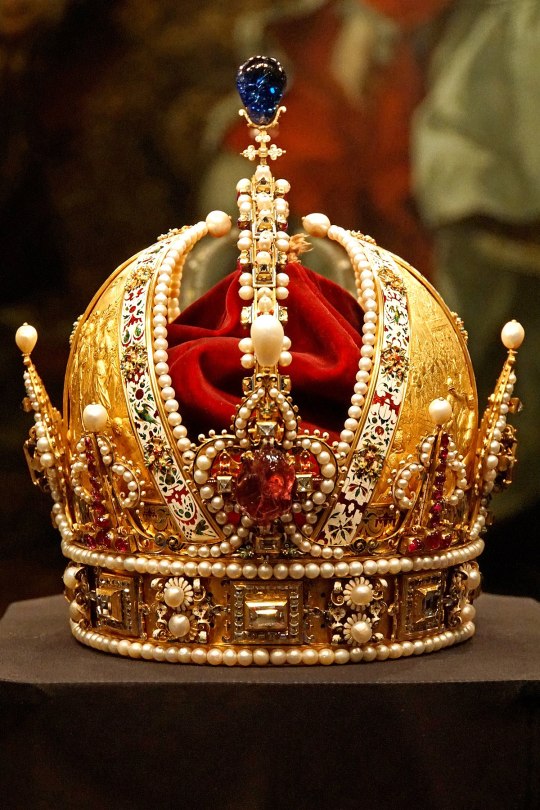
#catie: has never draw a crown in her life besides sketching and chibis#also catie: instantly decides to try to draw the most complicated one#im cursing you rudolph ii why did you have to be so tasteful#i still dont know tho if this is easier or harder than the holy roman empire crown#i think the general shape of the empire one is easier but the details are harder? idk honestly#and the crown im drawing is barely in any paintings UGHHHHH#even the professional painters looked at this and were like yeah nah im just putting that in the background#i don't wanna just give up and take it out of the painting bcs i think its cool#but idk if i can draw this 😭 its so complicated#its not even entirely historically accurate for seb to be wearing it#BIT I WANT HIM TOO SIB SOB SOB BCS IRS SO PRETTY#theres paintings of past emperors wearing the emperor crown so really i should be drawing that#but the austrian one is so much prettier 😭#so basically this crown was used as a personal crown by one emperor until the empire collapsed and then it became the imperial crown#so like techinally yeah seb shouldnt be wearing it bcs its for austria not the empire#but like cmon...in this au hes the type to wear a crown casually bcs bling bling yknow#but i am constantly cursed by historical accuracy#IDK WHAT TO DRAWWWWWWW#bcs i already drew the other austrian imperial stuff so i want the crown to match but ughhhhhh#catie.rambling.txt
13 notes
·
View notes
Text

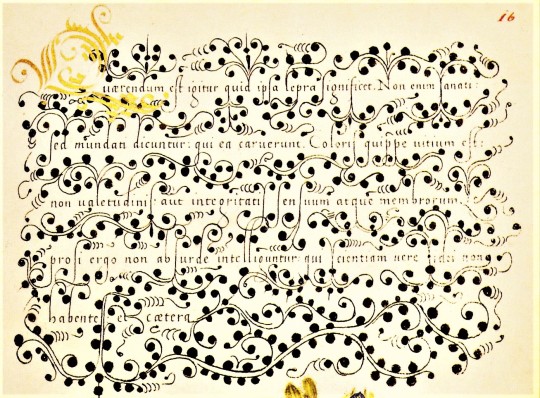

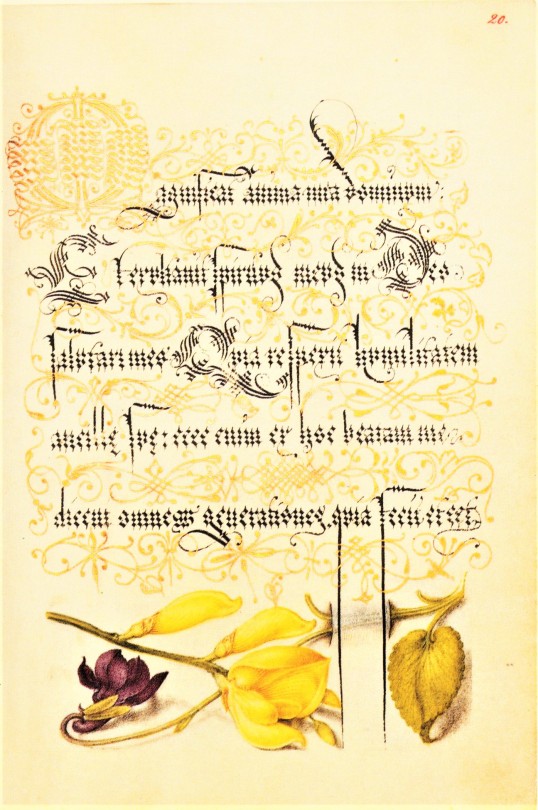


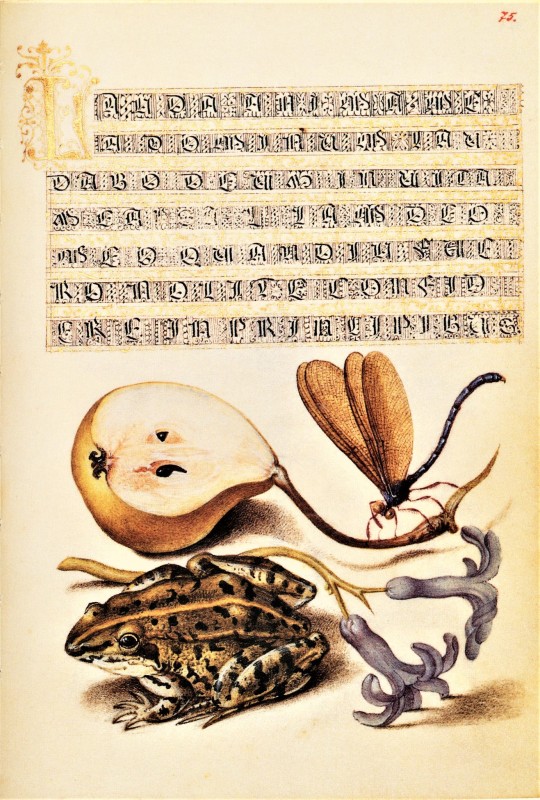



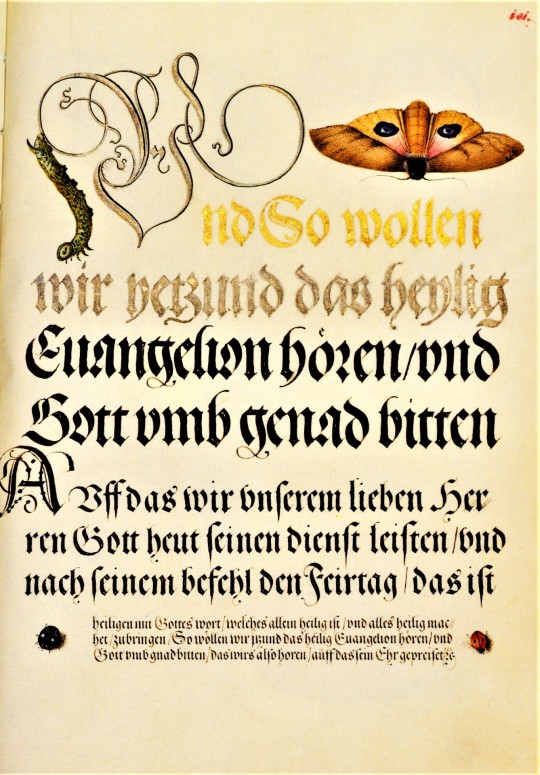

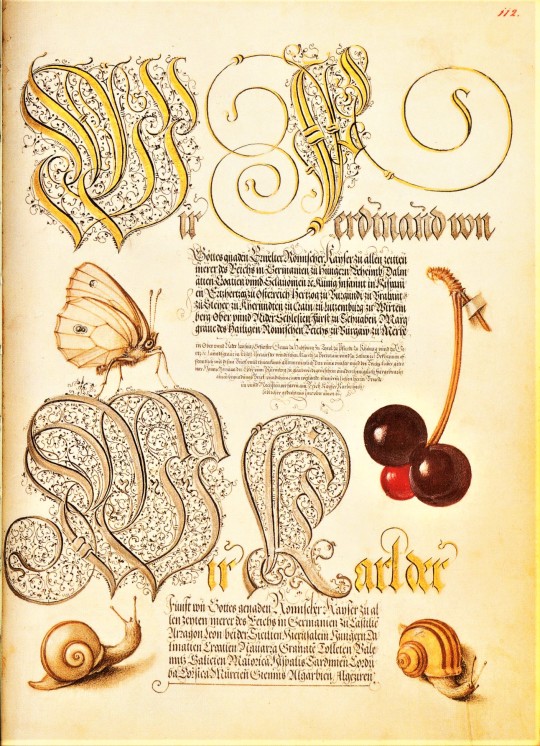
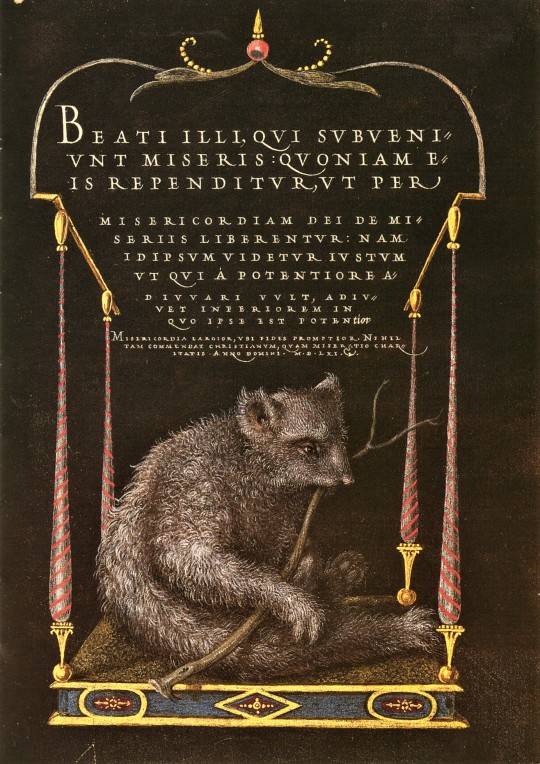
Typography Tuesday
We return to our facsimile of a 16th-cnetury calligraphic manuscript, Mira Calligraphiae Monumenta, or Model Book of Calligraphy, written in 1561/62 by Georg Bocskay, the Croatian-born court secretary to the Holy Roman Emperor Ferdinand I, and illuminated 30 years later by Flemish painter Joris Hoefnagel for the grandson of Ferdinand I, Emperor Rudolph II. The manuscript was produced by Bocskay in Vienna to demonstrate his technical mastery of the immense range of writing styles known to him. To complement and augment Bocskay's calligraphy, Hoefnagel added fruit, flowers, and insects to nearly every page, composing them so as to enhance the unity and balance of the page’s design. Although the two never met, the manuscript has an uncanny quality of collaboration about it.
Our facsimile was the first facsimile produced from the collection at the J. Paul Getty Museum in Los Angeles. It was printed in Lausanne, Switzerland by Imprimeries Reunies and published by Christopher Hudson in 1992.
View another post from Mira Calligraphiae Monumenta,
View more Typography Tuesday posts.
#Typography Tuesday#typetuesday#Mira Calligraphiae Monumenta#or Model Book of Calligraphy#Georg Bocskay#Joris Hoefnagel#illuminated manuscripts#manuscripts#manuscript facsimiles#facsimiles#calligraphy#letter forms#letters#J. Paul Getty Museum#Imprimeries Reunies#Christopher Hudson#Ferdinand I#Rudolph II
862 notes
·
View notes
Text
FE Awakening AU; Verdant Pegasi House



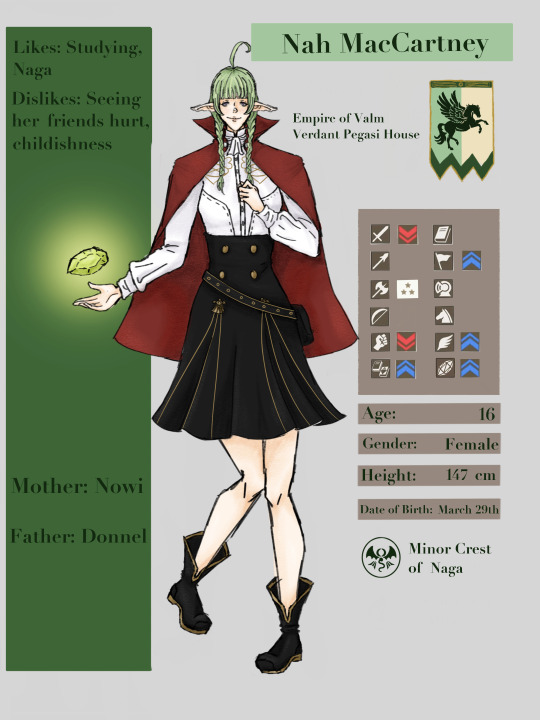




I finished these like 2 weeks ago but I've just been procrastinating lmao Last house‼️ Last three houses can be found here, here and here To the west lies the continent of Valm, home to the ancient gods Mila and Duma. Long ago, King Albein Alm Rudolph II and Queen Anthiese von Lima united the kingdoms to form Valentia. Union wouldn't last after their reign and as such, the continent was divided once again. Small countries throughout the land popped up, each with their unique cultures. 15 years ago, King Walhart Alm Rudolph I sought out to reunite the continent of Valm under one empire, thus crowning him Emperor. Though Valm pledged allegiance to no Gods, Tiki became a symbol of divinity and was embraced. As such, she allowed them one house in her Academy. The Verdant Pegasi gain their names from their vast and beautiful green plains and the abundance of wild Pegasi in many of their regions. They value honor, hardship, determination and kindness. Walhart II: Eldest son of the Emperor, he's determined to continue his father's rule over the continent and keep the empire afloat. Stern and headstrong, he's not afraid of a challenge. He enrolled in the Academy to strengthen his skills and hopefully make new allies. Yuu'ya: Only son of Say'ri, he embodies the image of a warrior of Chon'sin. Opposed to the united Valm, he's secretly amassing a rebel army to go against the foreign occupation of his land. Usually quiet and reserved, he rarely lets his presence be known. Kazu'sa: Oldest son of Yen'fay, he openly rejects his father's submission to Valm. He's growing to detest his father and his actions and strives to free his country. Despite having the same goals as his cousin, he's the polar opposite. Loud, brash and vulgar; he doesn't care for tradition and prefers to express himself freely. Nah: Nowi and Donnel's youngest daughter, she's pretty composed and reserved for her age. Growing up amongst so many other manaketes in the Church has allowed her to understand her culture and come to terms with her human half. Naga's descendants never usually take up any last names, but Nah insisted in taking her father's as a way to combine her two backgrounds. Aurelia: General Pheros's only daughter, she's hopes to become a Knight of Naga after graduation. She dedicates her life to her faith and holds Tiki in extremely high esteem. While she should usually inherit her house, she has stepped away from her noble lineage to pursue her dreams. Benedict: Youngest son of The Great Ignatius of Valm, his father's war prowess inspired him to follow in his footsteps. With great honor, he's taught himself all ways of magic to assist Walhart II in his future endeavors. Rumor has it, though, that he's terrified of boats. Hildegard: Daughter of Commander Farber, she's delicate as a flower. Shy, reserved and unassuming; she enrolled in the Academy to become a great healer to save lives. She fully expects to be married off for political gain, since she's a noble; but her only hope is to help those in need. Gerome: Heir to the Head of House Rosanne, Gerome focuses on his strength above all else. His father surrendering his homeland so easily to Valm has left him estranged from him over the years. He enrolled in the Academy for 2 reasons; to learn from his Mother, who's an instructor and to reunite with Lucina and the others in hopes of gaining their strength to drive back Valm. Crest of Duma: May half damage of an attack. Crest of Mila: Heals 20% of HP at the start of every turn. Crest of Chon'sin: Increases Crit chance by 20% Crest of Naga: Allows wielder to transform into a Manakete. Crest of Rosanne: May nullify effective damage
#artists on tumblr#fire emblem#fire emblem three houses#fire emblem au#fe oc#fe3h#fanart#fe3h au#fe awakening#fire emblem awakening#alm fire emblem#walhart fire emblem#celica fire emblem#say'ri fire emblem#yen'fay fire emblem#pheros fire emblem#farber fire emblem#ignatius fire emblem#nah fire emblem#gerome fire emblem#i cant believe i actually finished this au lmao#okay well im still working on church faculty but point still stands#holy moly it only took like 5 months
26 notes
·
View notes
Text
As an interest check:
Best Holy Roman Emperor:
Pros: Rerunning some of the contestants in this bracket, but also go back further and expand beyond the Habsburgs. Another chance for people to vote for Rudolph II's fruity...portrait.
Cons: Between us and @best-bourbon-monarch, we have probably already covered most of them.
Another German Dynasy:
Pros: We can include people who are also interesting in the same time period. The Saxons and the Bavarians have yet to appear, so it will open opportunities for more rp.
Cons: Admin 1 will have to do more reading and start a new blog, because they're primarily a Habsburg person.
Continue with a different tournament here:
Pros: This blog is already established and we could start immediately with something new after the final.
Cons: this is likely to be less interesting than the actual monarch bracket.
Napoleonic Sexyman Tournament:
Pros: This will be very fun and more than a little unhinged. I will get to ask you if Metternich is hot again. As someone specializing in the nineteenth century, this will be in admin 1's wheelhouse.
Cons: This will be unhinged
#this is an interest check for my own information#please tell me what you think#I'm having too much fun and I don't want it to stop
57 notes
·
View notes
Text
All right, so I have news for anyone who's interested in my Jewsade/Jewish dæmonism stuff! After not doing anything with it since I've hit a wall with no idea on how to actually write it, I am now considering using Maharal of Prague as a framing device that could connect the story to the main characters of His Dark Materials. Maharal is most well known for having rumored to have created a Golem - it's actually the most famous Golem story to exist - but he was more interesting a person than that. He was well studies in Philosophy and Kabbalah, as well as Astronomy and various other sciences. He was born in Poland about 30 years after the Alhambra decree in Spain, meaning he was a baby/young child at the time the supposed Jewsade may have occured. He was known to have conversed with Emperor Rudolph II later in life. In addition, his teachings later influenced the Chassidut movement.
I'm not really explaining his significance well, but he is an important figure who had the Golem legend grow around his character and fights against Blood Libels centuries after his death. And the fact that the Alethiometer was supposedly invented in Prague at around the time of his death helps.
You see, my idea of it currently is something along the lines of: Lyra, in the midst of studying the Alethiometer, finds some vague references to an early scholar named Long Loew. There is only one note from him which is very interesting, but there's very little about who he was and what are other stuff he said. After researching she finds a book that explains a bit more about him, which might be the heart of the story. That, or she'll slowly uncover hints and the story will progress in two parallel lines - one telling of the life of Rabbi Yehuda Loew of Prague and his struggles with the rising power of the Magisterium and another about Lyra uncovering his life and learning about the current state of Judaism under the Magisterium-dominated Europe. It will likely include some throwaway lines about the Jewsade and its outcome and about shifts in centers of Judaism. Some spotlight might also be given to Rabbi Mordechai Yaffeh (but only because I like him. He doesn't seem to have interacted with Maharal much even though he also served as the Rabbi of Prague for some time while Maharal was living in another city) and to some of Mahahral's students. There will also have to be some talk about the Shulchan Aruch and such books, but that's another thing.
Part of the idea here is also to remind people that Jews were involved in scientific development, to a degree. Some famous rabbis had exchanges with famous Astronomers. Due to how a Christian-dominated world generally works, though, you're unlikely to find discoveries made by Jewish scholars around the 16th-17th centuries. At least so I think, I'm far from an expert on that topic. Either way, I think this kind of story might lend itself easier to write. It does lose the angle of focusing on Sepharadi Jews, but I'm hardly qualified for that anyway. I think Maharal's type of philosophy might work very well with dæmons and the Alethiometer, though I do need to study it more (which I guess makes the fact one of my distant great uncles was a scholar of Maharal very convenient). I do still need to read the Secret Commonwealth to understand adult Lyra better and see how such a story might work - for example, might Pantalaimon go alone to the Jewish quarter of Prague when Lyra is unwilling to? What would each of them find out? What could really drive Lyra to check out one particular scholar? So, that's the bad news: after having a hard time starting to read the Secret Commonwealth, any progress that might be done is postponed until after I read it. I do intend to try and do it quickly, though.
So, yeah. I intend trying to talk about Jewish life in Lyra's world through the eyes of an old Jewish Rabbi, Philosopher and Kabbalah student, or maybe two or three of those. I will need to thouroughly research their history, but that's going to be fun (hopefully). Plus, I'm descended from Maharal! So this is kind of uncovering family history!
Thank you for reading, and have a wonderful day!
#judaism#jumblr#jewblr#jewish fantasy#his dark materials#jewish history#alternate history#the Jewsade#jewish dæmons#dæmonverse judaism#alternate jewish history#lyra's world#maharal of prague#maharal#long loew is a nickname i vaguely remember he had#he was very tall apparently#this did not pass down in the genes#the alethiometer#pavel khunrath#he wasn't mentioned in the post#but is kind of important to the story#lyra silvertongue#pantalaimon#hdm#the secret commonwealth#this is my new jewish dæmons post for now#pieces of prose may be introduced in the future#arch writes#arch's unfinished stories
11 notes
·
View notes
Text
Events 6.15 (before 1900)
763 BC – Assyrians record a solar eclipse that is later used to fix the chronology of Mesopotamian history. 844 – Louis II is crowned as king of Italy at Rome by pope Sergius II. 923 – Battle of Soissons: King Robert I of France is killed and King Charles the Simple is arrested by the supporters of Duke Rudolph of Burgundy. 1184 – The naval Battle of Fimreite is won by the Birkebeiner pretender Sverre Sigurdsson. Sigurdsson takes the Norwegian throne and King Magnus V of Norway is killed. 1215 – King John of England puts his seal to Magna Carta. 1219 – Northern Crusades: Danish victory at the Battle of Lindanise (modern-day Tallinn) establishes the Danish Duchy of Estonia. 1246 – With the death of Frederick II, Duke of Austria, the Babenberg dynasty ends in Austria. 1300 – The city of Bilbao is founded. 1312 – At the Battle of Rozgony, King Charles I of Hungary wins a decisive victory over the family of Palatine Amade Aba. 1389 – Battle of Kosovo: The Ottoman Empire defeats Serbs and Bosnians. 1410 – In a decisive battle at Onon River, the Mongol forces of Oljei Temur were decimated by the Chinese armies of the Yongle Emperor. 1410 – Ottoman Interregnum: Süleyman Çelebi defeats his brother Musa Çelebi outside the Byzantine capital, Constantinople. 1502 – Christopher Columbus lands on the island of Martinique on his fourth voyage. 1520 – Pope Leo X threatens to excommunicate Martin Luther in Exsurge Domine. 1607 – Virginia Colonists finished building James's Fort, to defend against Spanish and Indian attacks. 1648 – Margaret Jones is hanged in Boston for witchcraft in the first such execution for the Massachusetts Bay Colony. 1667 – The first human blood transfusion is administered by Dr. Jean-Baptiste Denys. 1670 – The first stone of Fort Ricasoli is laid down in Malta. 1752 – Benjamin Franklin proves that lightning is electricity (traditional date, the exact date is unknown). 1776 – Delaware Separation Day: Delaware votes to suspend government under the British Crown and separate officially from Pennsylvania. 1800 – The Provisional Army of the United States is dissolved. 1804 – New Hampshire approves the Twelfth Amendment to the United States Constitution, ratifying the document. 1808 – Joseph Bonaparte becomes King of Spain. 1834 – The looting of Safed commences. 1836 – Arkansas is admitted as the 25th U.S. state. 1844 – Charles Goodyear receives a patent for vulcanization, a process to strengthen rubber. 1846 – The Oregon Treaty extends the border between the United States and British North America, established by the Treaty of 1818, westward to the Pacific Ocean. 1859 – Ambiguity in the Oregon Treaty leads to the "Northwestern Boundary Dispute" between American and British/Canadian settlers. 1864 – American Civil War: The Second Battle of Petersburg begins. 1864 – Arlington National Cemetery is established when 200 acres (0.81 km2) of the Arlington estate (formerly owned by the family of Confederate General Robert E. Lee) are officially set aside as a military cemetery by U.S. Secretary of War Edwin M. Stanton. 1877 – Henry Ossian Flipper becomes the first African American cadet to graduate from the United States Military Academy. 1878 – Eadweard Muybridge takes a series of photographs to prove that all four feet of a horse leave the ground when it runs; the study becomes the basis of motion pictures. 1888 – Crown Prince Wilhelm becomes Kaiser Wilhelm II; he will be the last Emperor of the German Empire. Due to the death of his predecessors Wilhelm I and Frederick III, 1888 is the Year of the Three Emperors. 1896 – One of the deadliest tsunamis in Japan's history kills more than 22,000 people.
2 notes
·
View notes
Text
SAINT OF THE DAY (December 16)
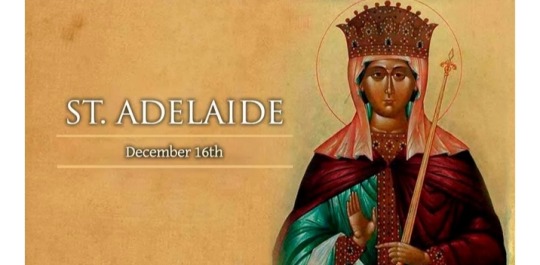
Born in 931 as the daughter of King Rudolph II of Burgundy, Adelaide was promised in marriage when she was only two years old to a man named Lothaire, the son and heir of his enemy, Hugh of Provence.
Lothaire was killed when still young, and Adelaide was to have a tumultuous life that paralleled the struggle for political power of the times, something she had come to symbolize.
She appealed to Otho the Great of Germany for help.
Having been sought after by various kings and nobles after Lothaire’s death, she was finally married by Otho the Great of Germany, who had invaded Italy.
After Otto’s death on 7 May 973, Adelaide exercised influence over her son Otto II until their estrangement in 978, when she left the court and lived in Burgundy with her brother King Conrad.
At Conrad’s urging, she became reconciled with her son. Before his death in 983, Otto appointed her his regent in Italy.
With her daughter-in-law, Empress Theophano, she upheld the right of her three-year-old grandson Otto III to the German throne.
She lived in Lombardy from 985 to 991, when she returned to Germany to serve as sole regent after Theophano’s death (991).
In 991, Adelaide was invested as the Regent of the Empire.
She used her power as the effective empress to increase evangelization efforts, especially in northern Europe.
She built many monasteries and churches, and also gave much aid the poor.
She governed until Otto III came of age in 994. When he became Holy Roman emperor in 996, she retired from court life, devoting herself to founding churches, monasteries, and convents.
She died in 999 at the monastery of Seltz, Alsace. She was canonized in 1097 by Pope Urban II.
4 notes
·
View notes
Text

Vertumnus (Emperor Rudolph II)
Giuseppe Arcimboldo · 1591
0 notes
Text

Garden Chicory ('Chicory Hortense').
Hand-coloured woodblock print by Giorgio Liberale.
From the Czech edition (1562) of the herbal by Pietro Andrea Mattioli in cooperation with Tadeáš Hájek z Hájku. [A herbal is a treatise that was (and possibly still is) a foundational text on the medical uses of plants.]
SIDE NOTE:
The following info is from Wikipedia.
Tadeáš Hájek z Hájku was a Czech naturalist, personal physician of the Holy Roman Emperor Rudolph II and an astronomer in the Kingdom of Bohemia.
He was in frequent scientific correspondence with the recognized astronomer Tycho Brahe (1546–1601) and played an important role in persuading Rudolph II to invite Brahe (and later Kepler) to Prague.
His voluminous writings in Latin were mostly concerned with astronomy and many regarded him as the greatest astronomer of his time. Besides his work, Tadeáš Hájek eagerly collected manuscripts, especially those by Copernicus.
ADD LINK TO PREVIOUS POST CIRCA APRIL 2022 RE. TYCHO BRAHE, RUDOLPH II & KEPLER.
Throughout his life Hájek also published numerous astrological prognostics in Czech and that is why he was until recently viewed as an "occultist" rather than a great scientist. He corresponded with John Dee as a result of their common interest in Euclid and geometry.
The lunar crater Hagecius and the asteroid 1995 Hajek are named in his honour.
Pietro Andrea Mattioli was a renowned Italian botanist and physician. He held a post in the Imperial Court as physician to Ferdinand II, Archduke of Austria, and the Emperor Maximilian II, Holy Roman Emperor.
Further research re. the use of woodblock engravings:
After the early 1600s woodblocks fell out of general use for botanical illustrations, as authors and printers began to favor the greater detail was possible to achieve more easily by using engraved plates
Ref. the website of the Folger Shakespeare Library (based in the Capitol Hill neighbourhood of Washington, DC. Link here.
Hurriedly cobbled together before breakfast, needs checking.
0 notes
Text

THE DESCRIPTION OF SAINT HENRY II, THE HOLY ROMAN EMPEROR Feast Day: July 13
Henry II, also known as Henry the Exuberant, was born on May 6, 973 AD in Bavaria, Germany, Holy Roman Empire, and is the son of Henry II of Bavaria and Gisela of Burgundy. He was Henry I of Bavaria's grandson through his father, and is the great-grandson of Henry the Fowler. On his mother's side, he was the grandson of Conrad the Peaceful, and the great-grandson of King Rudolph II of Burgundy.
He was educated in the Christian faith by Wolfgang of Regensburg during his father's exile, and studied at Hildesheim Cathedral. The Emperor himself ensured the younger Henry received an ecclesiastical education in order that by becoming a religious official he would be prevented from participating in the Imperial government.
The death of Otto II in 983 allowed the elder Henry to be released from custody and to return from exile. The elder Henry claimed regency over Otto III, the three-year-old child of Otto II. After a failed attempt to claim the German throne for himself in 985, the elder Henry relinquished the regency to the child's mother Theophanu.
In return for his submission to the child king, Henry was restored as Duke of Bavaria. The younger Henry, now thirteen years old, was named his regent over Bavaria. When the elder Henry died in 995, the younger Henry was elected by the Bavarian nobles as the new duke to succeed his father.
Sincerely religious, Henry II supported service to the Church (he was celibate) and promoted various monastic reforms. He also strongly enforced clerical celibacy, perhaps partly in order that the public land and offices he granted to clerics would not be devised to heirs. He encouraged the reform of the Church, fostered missionary activity, and made several charitable foundations for the poor.
Wished to become a monk, and in virtue of his imperial power he ordered the Abbot of Verdun to accept him in his monastery. Thereupon, the Abbot ordered him, in virtue of the vows he had professed, to continue the administration of the empire. Henry II fulfilled his duties in the spirit of humility and service, being convinced that temporal power was given by God for the good of the people.
He succeeded in persuading Pope Benedict VIII to include the word 'Filioque' in the Nicene Creed. The addition of the term provided that the Holy Spirit emanated from both God the Father and God the Son.
Together with the concept of Papal primacy, dispute over this doctrine was one of the primary causes of the Great Schism of the Church in 1054.
Henry II inherited several unresolved ecclesiastical disputes from his predecessor Otto III. Issues of particular importance were the reestablishment of the Diocese of Merseburg and the settlement of the Gandersheim Conflict.
Returning to Magdeburg, Germany from southern Italy to celebrate Easter, he fell ill in Bamberg. After celebrating Easter, Henry retired to his imperial palace in Göttingen, and died there on July 13, 1024 at the age of 51, without an heir, and thus Henry II is the last of the Saxon kings.
Henry II is canonized as a saint by Pope Eugenius III in July 1147; while Cunigunde of Luxembourg, his spouse, was canonized on March 29, 1200 by Pope Innocent III. Henry's relics were carried on campaigns against heretics in the 1160s.
He is the patron saint of the city of Basel, Switzerland, and of St. Henry's Marist Brothers' College in Durban, South Africa. During his lifetime, Henry II became an oblate of the Benedictine Order, and today is venerated within the Order as the patron saint of all oblates, along with St. Frances of Rome.
#random stuff#catholic#catholic saints#henry ii#saint henry#san enrique#san enrique ii#enrique II de alemania#henry the exuberant#holy roman emperor#benedictines
0 notes
Text

"Jupiter and Io" by Matthäus Gundelach (1566-1653), German manneristic painter in service of Emperor Rudolph II. Habsburg
0 notes
Photo

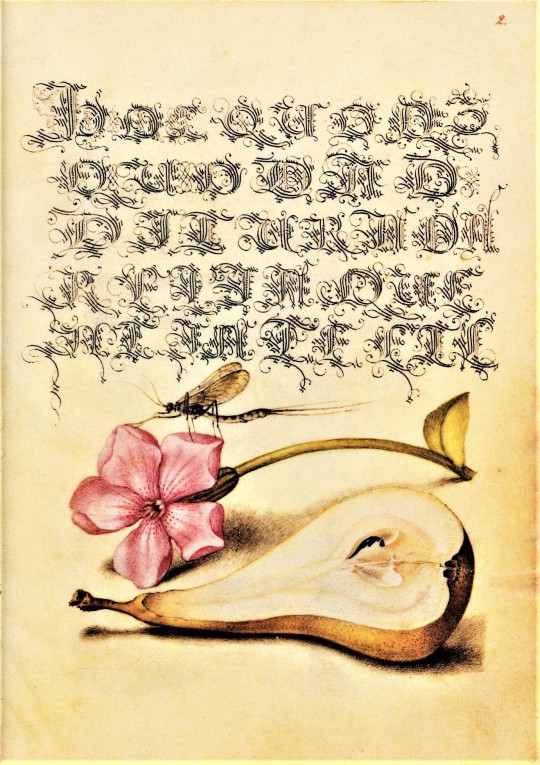
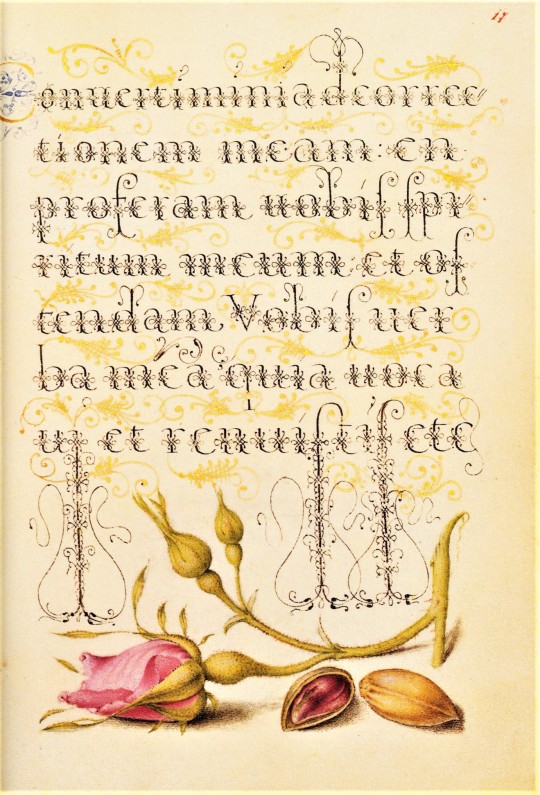




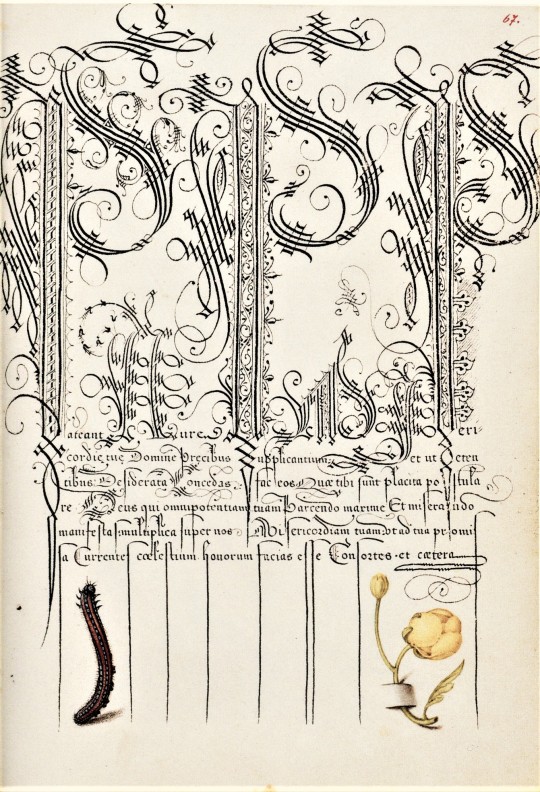

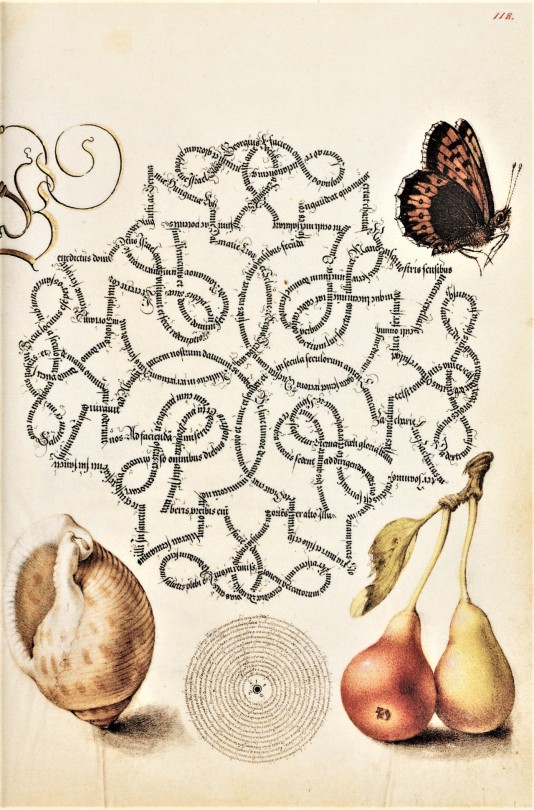
Typography Tuesday
Sometimes, things in our collection still surprise me, even after 29 years. From our fairly sizable manuscript facsimile collection, I was surprised I had never encountered this little (5 X 7 in.) reproduction of a 16th-cnetury calligraphic manuscript, Mira Calligraphiae Monumenta, the first facsimile produced from the collection at the J. Paul Getty Museum in Los Angeles, printed in Lausanne, Switzerland by Imprimeries Reunies and published by Christopher Hudson in 1992.
As the relatively new invention of printing came to dominate the production of books by the 1500s, the calligraphic inventiveness of scribes became prized for their aesthetic qualities rather than their production value.
From 1561 to 1562, Georg Bocskay, the Croatian-born court secretary to the Holy Roman Emperor Ferdinand I, created this Model Book of Calligraphy in Vienna to demonstrate his technical mastery of the immense range of writing styles known to him. About thirty years later, Emperor Rudolph II, Ferdinand's grandson, commissioned the [Flemish painter] Joris Hoefnagel to illuminate Bocskay's model book. Hoefnagel added fruit, flowers, and insects to nearly every page, composing them so as to enhance the unity and balance of the page's design. -- Getty Museum Collection webpage.
Although the two never met, the manuscript has an uncanny quality of collaboration about it.
Today we only show 11 pages from the facsimile, but we hope to present more from this highly-inventive manuscript of calligraphic virtuosity in the future.

View more Typography Tuesday posts.
-- MAX, Head, Special Collections
#Typography Tuesday#typetuesday#Typography Tuesday#Mira Calligraphiae Monumenta#Georg Bocskay#Joris Hoefnagel#calligraphy#letter forms#letters#J. Paul Getty Museum#Imprimeries Reunies#Christopher Hudson#illuminated manuscripts#facsimiles#manuscript facsimiles#Ferdinand I#Rudolph II
142 notes
·
View notes
Text
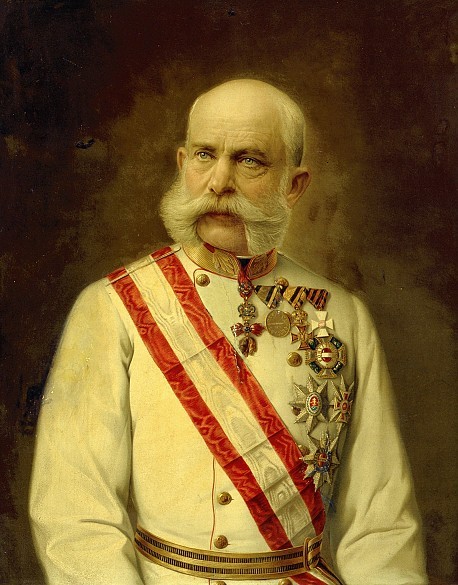
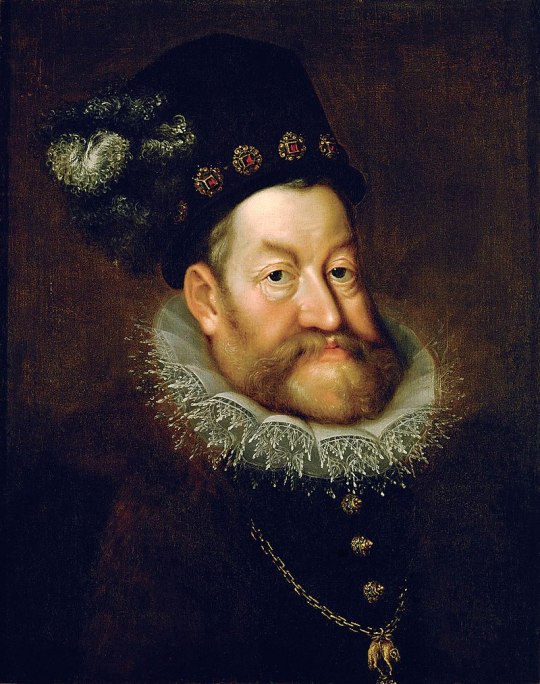
Franz Joseph, Emperor of Austria, reign: 1848-1916
- Now greyer than the previous polls
Rudolph II, Holy Roman Emperor, reign: 1576-1612
He wanted to be an alchemist not an emperor
Propaganda Under the cut for both:
For Franz Joseph:
By: @minetteskvareninova
- as much of a poor little meow meow as Joseph II
- also known as Starej Procházka (ask @archduchessofnowhere I promise it's hillarious)
- was there not for a good time, but a long time certainly, and unlike queen Victoria doesn't even get the dignity of an era named after him!!!
- wholesome friendship with Katharina Schratt
- girldad (better not ask about his son)
- loved the great god Mars, even though Mars did not love him back, wore uniform all the fucking time, but his actually military record was. well. gotta love a boyfailure.
- conservative in principle, but smart enough to know when to fold 'dem (which is why the former monarchy didn't end up like Russia)
By: anonymous
- Dual Monarchy. HELLO.
- Constitution! (Italy immediately declared war after but ya know)
- Survived assassination attempts
- Doesn't lose territory to Prussian unification which is something I guess
- Shares 2 names with Hayden
For Rudolph II:
- THE ABSOLUTE BICON 💗💜💙
- Contributions to art and science!!! Alchemy, astronomy, painting etc flourished in his court we literally have some of the most beautiful baroque artefacts because of him
- Where do you think that pretty little crown in the polls icon came from
- Would rather do that than politics so real king
- Accused of doing occult? He's THAT astrology witchblr bitch
- Mental illness girlies rep!!!
- Possibly neurodivergent girlies rep also!!
- VERY misunderstood and poor little meow meow uwu everyone thought he was incompetent and horny and cray cray like it was a bad thing
- We've voted on twinks? BEARS need love too!!! 💅
- Would've LOVED tumblr tbh he walked so all of us today could run 🩷🩷🩷
Fun fruit portrait:
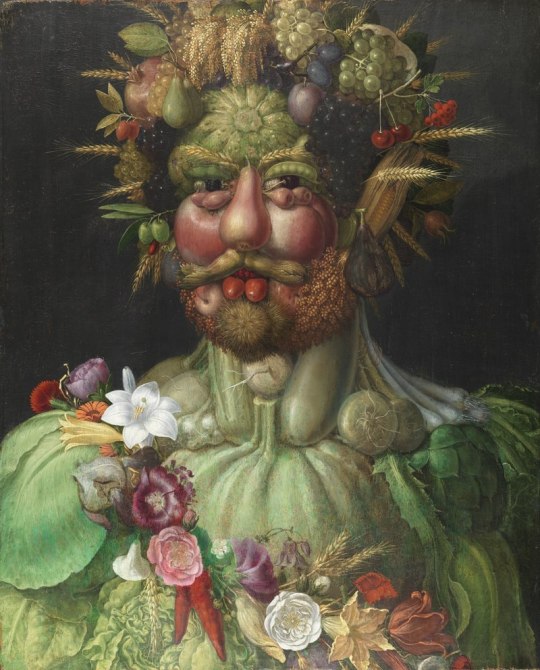
#best habsburg bracket#house of habsburg#franz joseph i#rudolph ii#congratulations to Franz Joseph for getting far enough for me to use his old man portrait
86 notes
·
View notes
Photo




Allegories of the Four Seasons (Fountain Figures), between 1569 and 1578.
In 1568, Emperor Maximilian II commissioned a silver fountain measuring more than three meters in height from the goldsmith Wenzel Jamnitzer. Both by its decorative program and by its ingenious engineering it was to glorify the House of Habsburg. However, the monument was not delivered until nine years later, to Maximilian’s son and heir, Rudolph II. In the 18th century the silver parts were melted down in order to finance the refurbishment of the Treasury, and only these four supporting bronze figures have survived.
Gilded bronze
Kunsthistorisches Museum Wien
178 notes
·
View notes